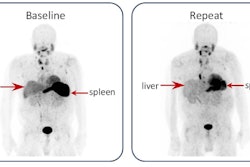A deep-learning AI model shows promise in helping clinicians assess cardiac sarcoidosis on PET scans, according to research presented on September 6 at the American Society of Nuclear Cardiology annual meeting in Austin, TX.
The model automatically segments areas of suspected disease based on F-18 FDG radiotracer uptake and could significantly improve the processing of cardiac sarcoidosis PET studies, according to Alexis Poitrasson-Riviere, PhD, of the University of Michigan spinoff company Invia, and colleagues.
"This tool could significantly enhance clinical workflow by decreasing processing time and improving consistency and quality," the group noted in a session on ischemic heart disease.
FDG-PET imaging of glucose metabolism in the myocardium has become a clinical standard for diagnosing cardiac sarcoidosis, the researchers explained. The technique identifies areas of inflammation caused by the growth of tiny collections of inflammatory cells. In the absence of treatment, the disease can lead to irreversible fibrosis and sudden cardiac death.
Currently, clinicians manually segment areas of disease on FDG-PET scans, a time-consuming process that involves the registration and transfer of contours from perfusion datasets, they noted. To determine whether AI could help improve clinical workflows, the group developed a 3D U-Net deep-learning (DL) model trained on manually segmented scans from 316 patients.
To test the model, physicians compared "readability" -- how accurately they could interpret the segmented images -- based on screen captures of images automatically segmented by the DL algorithm versus manually segmented images. They also assessed the consistency of the AI model and clinicians (so-called "interuser repeatability") for specific measurements, namely left ventricle displacement and angulation, as well as peak standard uptake value (SUV) sampling.
 Examples of the standard myocardial perfusion imaging (MPI) segmentation, DL segmentation, and manual segmentation for negative (a) and positive (b) FDG-PET studies. Image courtesy of the American Society of Nuclear Cardiology.
Examples of the standard myocardial perfusion imaging (MPI) segmentation, DL segmentation, and manual segmentation for negative (a) and positive (b) FDG-PET studies. Image courtesy of the American Society of Nuclear Cardiology.
According to the findings, the DL segmentation algorithm enhanced readability scores in over 90% of cases compared to the manually segmented images. In addition, the DL model produced results that were close to the variability among physician readers for left ventricle displacement (7.71 mm versus 4.96 mm) and angulation (5.97° versus 3.93°). There was no significant difference in variability in the DL model's measurements of peak SUV and those by readers using standard methods.
"The DL segmentation algorithm greatly improves the processing of cardiac sarcoidosis FDG PET studies," the group noted.
Ultimately, additional validation with multicenter data is warranted, Poitrasson-Riviere and colleagues concluded.




















